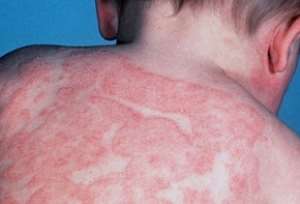
The term Atopy, meaning strange disease, designates allergic conditions that are mediated by reaginic antibodies. The reactions are always immediate, recur chronically, and if they place in the skin, they associated with an edematous, wheal-type skin reaction.
The tendency of atopy and the susceptibility to react to specific antigens are both inherited. Hypersensitivity reactions have been classified by Cell and Coombs into four categories based on the nature of the antibody or effector cell, the nature of the antigen, and indirectly the time course of the reaction.
In this classification, reagin-mediated allergy is considered as class I. Reactions involving the other types of immunoglobulins are considered as class II, if the antigen is cell-bound, or class III, if the antigen is soluble and tissue damage is caused by the deposition of antigen-antibody complexes.
Class IV reactions are cell-mediated and are commonly considered as the reactions of delayed hypersensitivity. However, the demarcation between humoral and cellular hypersensitivity is being progressively obliterated as we fully understand the details of both types of reactions.
The hallmark of the atopic disease is the rapid onset of symptoms, once sensitized individual contacts the responsible allergen. As we shall see later, the response results from pharmacologic mediators from sensitized tissue mast cells or blood basophils, the primary site of the reaction.
Therefore, the nature of the disease is in some measure determined by the route of exposure to the allergen. When the allergen is airborne, inhalant allergy, the reaction is primarily in the respiratory tract and sometimes the eyes.
When the allergen is ingested, food allergy, the reaction is in the gastrointestinal tract and in the skin. When the allergen is applied to the skin, the result may be urticaria.
It is important to stress that, in all cases, the diseases are known that share most, or all, of the symptomatology of the atopic diseases but do not have an underlying atopic etiology.
Examples are vasomotor rhinitis, food intolerance, such as milk intolerance caused by lactase deficiency, or intrinsic asthma. In many of these conditions, the release of mediators of anaphylaxis plays a role in the development of symptoms.
Therefore, therapy that inhibits the release of these mediators may still be beneficial.




 Dumsor: Energy sector ‘shepherdless’ – Nana Amoasi VII
Dumsor: Energy sector ‘shepherdless’ – Nana Amoasi VII
 Train accident: Four more grabbed and remanded
Train accident: Four more grabbed and remanded
 Gov't to consolidate cash waterfall revenue collection accounts
Gov't to consolidate cash waterfall revenue collection accounts
 Gov't to settle lump sum for retired teachers by April 27
Gov't to settle lump sum for retired teachers by April 27
 Former PPA CEO granted GH₵4million bail
Former PPA CEO granted GH₵4million bail
 Dumsor: The darkness has exposed you; you’ll go down as the worst in Ghana’s his...
Dumsor: The darkness has exposed you; you’ll go down as the worst in Ghana’s his...
 Dumsor: The ‘incompetent’ person provided a timetable whiles those who came to s...
Dumsor: The ‘incompetent’ person provided a timetable whiles those who came to s...
 Defend, ensure NPP’s good works are ‘sold’ and highlight the ‘bad’ state of the ...
Defend, ensure NPP’s good works are ‘sold’ and highlight the ‘bad’ state of the ...
 Bawumia will rank high ahead of Mahama in any anti-corruption test — Salam Musta...
Bawumia will rank high ahead of Mahama in any anti-corruption test — Salam Musta...
 NPP trying to bribe us but we‘ll not trade our integrity on the altar of corrupt...
NPP trying to bribe us but we‘ll not trade our integrity on the altar of corrupt...
